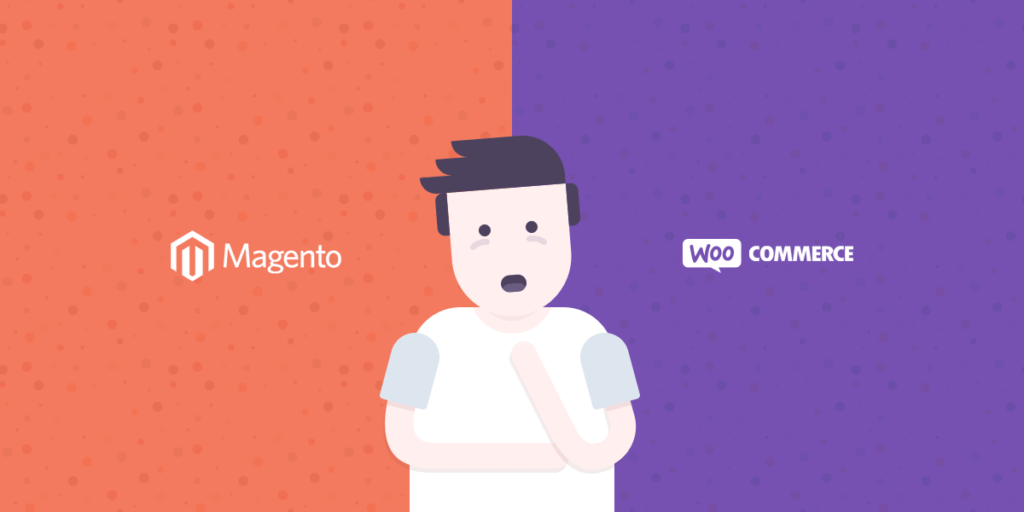Magento and WooCommerce can be considered the two “biggest guys” in the eCommerce industry. There are a lot of prolix and complicated comparison articles with the aim of selecting the winner between Magento vs WooCommerce, which makes us even more confused.
Therefore, we want to give you concise analytics to simplify the problem. Although only the key points are mentioned, it’s enough to make a decision about which platform is suitable for your business.
Contents
Magento Overview
Magento is an open-source eCommerce platform that allows online retailers to create and manage their own eCommerce stores. It is the most popular eCommerce platform on the web, accounting for more than a quarter of all online retailers.
Magento is designed specifically for eCommerce and offers a wide range of features and functionality that online retailers can use to create and manage their stores. These features include:
- A powerful shopping cart and checkout system
- A wide range of customizable product options and settings
- Advanced inventory management capabilities
- A robust marketing and SEO toolkit
- Comprehensive customer management features
Overall, Magento offers a very comprehensive set of features and functionality that online retailers can use to create and manage their eCommerce stores. It is this feature set that has made Magento the most popular eCommerce platform on the web.
WooCommerce Overview

WooCommerce is a powerful eCommerce plugin for WordPress. It’s the second most popular eCommerce platform after Magento, and it’s used by millions of businesses around the world.
WooCommerce is a very versatile platform, and it can be used for a wide range of businesses. It’s perfect for small businesses, and it can be scaled up to meet the needs of larger businesses.
One of the great things about WooCommerce is that it’s so versatile. It can be used for everything from a simple online store to a more complex eCommerce platform. And because WooCommerce is based on WordPress, it’s easy to use and manage.
WooCommerce is also very affordable. It’s free to download and use, and there are no monthly fees or subscription charges. This makes it an ideal choice for small businesses and startups.
If you’re looking for an affordable, versatile, and easy-to-use eCommerce platform, WooCommerce is a great choice. It’s used by millions of businesses around the world, and it’s perfect for small businesses and startups.
Similarities

There are eight common characteristics between Magento and WooCommerce as the followings:
Open-source
Both Magento and WooCommerce are open-source software, meaning that the code is publicly accessible and developers can contribute to the codebase. This makes both platforms very customizable and allows for a large community of developers to help with support.
Additionally, because the code is open-source, there is always the possibility of security vulnerabilities. However, because there is a large community of developers constantly working on these projects, security holes are usually patched quickly.
Easy to seek help from the community
Both Magento and WooCommerce have large online communities where users can go for support. This includes forums, social media groups, and even paid support options.
Both platforms offer a wide range of support options, so users can choose what works best for them. Magento may have a slight edge in terms of official support options, but WooCommerce has a more active community presence on social media.
Allow adding a blog to support SEO
Both Magento and WooCommerce allow you to add a blog to your site in order to improve your site’s SEO. This is a great way to add content and attract new visitors.
To add a blog to your Magento site, you first need to install the Magefan Blog Extension. Once installed, you can create a new blog by going to Content > Blog > Add New Blog.
Adding a blog to WooCommerce is a bit more complicated than Magento. First, you need to install the WordPress software on your site. Once WordPress is installed, you can then install the WooCommerce plugin.
After WooCommerce is installed, you can create a new blog by going to Appearance > Menus. On the Menus page, you will see an option to create a new “Blog” menu.
Allow viewing Google Analytics

Both Magento and WooCommerce allow you to view your Google Analytics data right in your admin panel. This gives you a detailed look at how your store is performing traffic-wise. You can see things like which pages are the most popular, where your visitors are coming from, and what time of day is the busiest for your store. This information can be invaluable in helping you to make decisions about how to improve your store’s traffic and sales.
Another great thing about using Magento or WooCommerce is that they both allow you to integrate your store with Google AdWords. This means that you can manage your advertising campaigns right from your admin panel. You can see things like which ads are performing the best, how much money you’re spending on advertising, and where your ads are being shown. This information can help you to fine-tune your campaigns and get the most out of your advertising budget.
Magento and WooCommerce are both great choices for setting up an online store. They both offer a lot of features and options that can help you to create a successful online business. If you’re looking for a platform that will allow you to view your Google Analytics data and manage your AdWords campaigns, then either Magento or WooCommerce would be a good choice for you.
Thousands of free & premium themes
Magento and WooCommerce both have thousands of free and premium themes available for you to choose from. This allows you to find a theme that fits your brand and style perfectly.
Additionally, both platforms offer a wide range of features and extensions to further customize your online store. Magento is especially known for its vast selection of third-party extensions.
So, if you’re looking for complete control over the look, feel, and functionality of your online store, either Magento or WooCommerce will be a good fit.
Easy to customize the design
Both Magento and WooCommerce allow you to easily customize the design of your store. You can change colors, fonts, layouts, and more with just a few clicks. If you want to get really creative, you can even create your own themes.
Magento: Magento’s theming system is quite sophisticated and allows for a lot of flexibility. If you’re familiar with HTML/CSS, you can easily create your own theme. Or, if you’d rather not deal with code, you can purchase a ready-made theme from one of the many Magento theme providers.
WooCommerce: WooCommerce also has a good selection of themes available, both free and paid. And like Magento, if you’re familiar with code, you can create your own theme. However, it’s worth noting that WooCommerce themes tend to be less customizable than Magento themes.
Allow to upload unlimited products and manage them effectively
Both Magento and WooCommerce allow you to upload unlimited products and manage them effectively. This makes it easy for you to stock your store with the products you want, without having to worry about running out of space. Additionally, both platforms offer a variety of tools to help you manage your inventory effectively. For example, you can set low-stock alerts to ensure that you never run out of a product, and you can create product bundles and kits to make it easy for customers to buy multiple items at once.
Both Magento and WooCommerce offer a wide range of reports that can help you track your inventory levels and sales data. This information can be used to help you make better decisions about the products you stock, the prices you charge, and the promotions you run.
In short, both Magento and WooCommerce offer everything you need to effectively manage an online store with unlimited products. So, if you’re looking for a platform that can handle a large inventory, then either of these two options would be a good choice.
Differences

On the other hand, Magento differs significantly from WooCommerce in terms of target customers, features, hosting, and so on.
| Magento | WooCommerce | |
|---|---|---|
| Definition | – The most popular e-commerce platform (account for more than a quarter of all online retailers) – Designed specifically for e-commerce | – A robust plugin for the WordPress platform – The 2nd most prevalent choice after Magento |
| Cost | – Both free & paid | – Completely free |
| Target customers | – Medium to large e-commerce retailers, who hire agencies to set up & manage their stores | – Small & medium-sized enterprises that have little coding experience |
| Installation | – Require technical skills | – Easy, can DIY |
| Hosting | – Run using dedicated servers or a cloud plan when the product portfolio grows – Use ample disk space | – Run using WordPress’s hosting – Use little disk space, be light on server space |
| Features | – Lots of features: Enable to cross-sell & up-sell your products, compare products, create coupon codes, and use an advanced filter to navigate the products – Provide different currencies, payment options, & multiple languages – Manage many stores on the same account – via one dashboard – Include APIs to connect with a third-party solution | – Limited features: Allow to rate products & feature bestsellers/ sale items through available widgets but require add-ons for more complicated things – Sotiphicated navigation can be filtered by one attribute – Include SSL support but require a certificate |
| Security | – Many advanced features & dedicated patches to handle any possible vulnerabilities | – Basic features |
Cost
When it comes to cost, Magento and WooCommerce offer different options. Magento offers both a free and paid version, while WooCommerce is completely free.
The free Magento option does have some limitations, such as not being able to use certain features or having a custom domain name. If you need those features, you will need to pay for the Magento license. The cost of the license varies depending on the size of your business, but can be expensive for larger businesses.
WooCommerce is completely free to use, with no limitations. This makes it a more affordable option for small businesses. There are also no transaction fees, which can save you money on each sale.
Target customers
Magento is best suited for medium to large eCommerce retailers who are looking for a platform that offers a lot of flexibility and customizability. Agencies often set up and manage Magento stores, as they require a fair amount of coding experience. Magento is also great for businesses that have a lot of products or need a sophisticated checkout process.
WooCommerce, on the other hand, is best suited for small and medium-sized enterprises that have little coding experience. It is a very user-friendly platform and does not require any coding knowledge. WooCommerce is also great for businesses that want to start selling online quickly and easily.
Installation

Magento is a more technically complex platform that requires developers to install it. For this reason, it may not be the best choice for businesses that don’t have the resources to invest in a dedicated development team. However, for businesses that are willing to invest in Magento development, the platform provides a lot of flexibility and functionality.
In contrast, WooCommerce is an easy platform that can be installed by business owners without any technical skills. The platform is also less expensive to set up and maintain, making it a good choice for small businesses. However, WooCommerce lacks some of the features and flexibility that Magento offers.
Hosting
Hosting is a critical component of any eCommerce store, and two of the most popular eCommerce platforms – Magento and WooCommerce – have different hosting needs.
Magento is a powerful platform that requires dedicated servers or a cloud plan when the product portfolio grows. WooCommerce, on the other hand, can be run using WordPress’s hosting and uses little disk space, making it light on server space.
When choosing a host for your Magento store, you’ll need to make sure that you have enough disk space and horsepower to support your traffic and product catalog. A good host will also offer 24/7 support and scalability so that your store can grow with your business.
For WooCommerce stores, WordPress’s hosting is generally more than adequate. However, if your store experiences high traffic or you have a large product catalog, you may need to upgrade to a more robust hosting plan.
Features
When it comes to features, Magento and WooCommerce are two very different platforms. Magento is known for its vast array of features, while WooCommerce is more limited in what it can do. However, this doesn’t mean that WooCommerce is any less powerful – it just has a different focus.
One of the biggest advantages of Magento is that it enables you to cross-sell and up-sell your products. You can also compare products, create coupon codes, and use an advanced filter to navigate the products.
Magento also supports multiple currencies, payment options, and languages. This makes it perfect for businesses with a global reach.
Managing multiple stores on the same account is also much easier with Magento thanks to its powerful dashboard. And if you need to connect with a third-party solution, Magento’s APIs make this possible.
WooCommerce, on the other hand, is best suited for businesses that want to feature their bestsellers or sale items through available widgets. It also includes SSL support, although you will need a certificate to take advantage of this.
WooCommerce is less sophisticated when it comes to navigation – it can be filtered by one attribute only. But for businesses that don’t need all the bells and whistles that Magento offers, WooCommerce is a great choice.
Security

Magento is known for its many advanced features and the dedicated patches it has to handle any possible vulnerabilities. WooCommerce, on the other hand, is more basic in terms of features, but still offers a high level of security.
One of the main benefits of Magento is that it is an open-source platform. This means that there are many developers who can work on fixing any potential security vulnerabilities.
Additionally, Magento has a large community that can help you with any problems you may encounter. WooCommerce is also a popular platform, but it is not open source. This means that there may be fewer developers who are able to help you with security issues.
Another key difference between Magento and WooCommerce is that Magento offers more features. This can be both a good and bad thing, as more features can make your site more vulnerable to attack.
However, Magento also has many built-in security features that can help protect your site. WooCommerce is less feature-rich, but it does have some built-in security features.
Which One Should You Choose?
There are many reasons why Woocommerce is more popular than Magento. One reason is that Woocommerce is free, while Magento costs money to use. Another reason is that Woocommerce is easier to use than Magento.
Despite these reasons, some businesses still choose Magento over Woocommerce. The main reason for this is that Magento offers more features than Woocommerce. For example, Magento can be used to create complex eCommerce websites, while Woocommerce cannot.
In the end, the choice between Magento and Woocommerce comes down to what you need your eCommerce website to do. If you need a website with complex features, then you should choose Magento. If you need a website that is easy to use and free, then you should choose Woocommerce.
Wrap Up
Actually, there is no ultimate answer to the question: “Who is the better between Magento and WooCommerce?”. You had better change the question to “Who is the better option for your business?” and I think now you have the answer for your own.
Tigren is one of the top agencies that have more than 10-year-experience in E-commerce website design and development. We have the strong expertise to build professional and user-friendly online stores that guarantee your sales. Primarily, we offer very competitive pricing to suit the budget of both small and large businesses, while the project quality is still guaranteed. Contact us and get a free quote and consultation for your project now!


